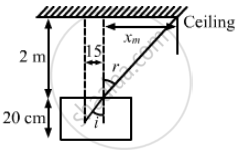Advertisements
Advertisements
प्रश्न
A container contains water up to a height of 20 cm and there is a point source at the centre of the bottom of the container. A rubber ring of radius r floats centrally on the water. The ceiling of the room is 2.0 m above the water surface. (a) Find the radius of the shadow of the ring formed on the ceiling if r = 15 cm. (b) Find the maximum value of r for which the shadow of the ring is formed on the ceiling. Refractive index of water = 4/3.
उत्तर
Given,
Height (h) of the water in the container = 20 cm
Ceiling of the room is 2.0 m above the water surface.
Radius of the rubber ring = r
Refractive index of water = 4/3
From the figure, we can infer:
\[\sin i = \frac{15}{25}\]
Using Snell's law, we get:
\[\frac{\sin i}{\sin r} = \frac{1}{\mu} = \frac{3}{4}\]
\[ \Rightarrow \sin i = \frac{4}{5}\]
From the figure, we have:
\[So, \]
\[\sin r = \frac{\tan r}{\sqrt{1 + \tan^2 r}}\]
\[ = \frac{\frac{x}{2}}{\sqrt{1 + \frac{x^2}{4}}}\]
\[ \Rightarrow \frac{x}{\sqrt{4 + x^2}} = \frac{4}{5}\]
\[\Rightarrow 25 x^2 = 16(4 + x^2 )\]
\[ \Rightarrow 9 x^2 = 64\]
\[ \Rightarrow x = \frac{8}{3} m\]
Total radius of the shadow = \[\frac{8}{3} + 0 . 15 = 2 . 81 m\]
(b)
Condition for the maximum value of r:
Angle of incidence should be equal to the critical angle, i.e., \[i = \theta_c\]
Let us take R as the maximum radius.
Now,
\[\sin \theta_c = \frac{\sin \theta_c}{\sin r}\]
\[ = \frac{R}{\sqrt{R^2 + 20}} = \frac{3}{4} (\sin r = 1)\]
\[ \Rightarrow 16 R^2 = 9 R^2 + 9 \times 400\]
\[ \Rightarrow 7 R^2 = 9 R^2 + 9 \times 400\]
\[ \Rightarrow R = 22 . 67 cm\]
APPEARS IN
संबंधित प्रश्न
Give a scientific reason:
Danger signals are red in colour.
Fill in the blank:
Very fine particles mainly scatter ………… colored light.
Why does unpolarised light from a source show a variation in intensity when viewed through a polaroid which is rotated?
Draw the intensity distribution for the fringes produced in interference ?
Draw the intensity distribution for the diffraction bands produced due to single slit ?
Why does the Sun look reddish at sunset or sunrise ?
In the meterbridge experimental set up, shown in the figure, the null point ‘D’ is obtained at a distance of 40 cm from end A of the meterbridge wire. If a resistance of 10Ω is connected in series with R1, null point is obtained at AD = 60 cm. Calculate the values of R1 and R2.
A convex lens is made of a material having refractive index
\[1 \cdot 2\] Both the surfaces of the lens are convex. If it is dipped into water (μ = 1.33), it will behave like
A concave mirror forms an image of 20 cm high object on a screen placed 5.0 m away from the mirror. The height of the image is 50 cm. Find the focal length of the mirror and the distance between the mirror and the object.
A candle flame 1.6 cm high is imaged in a ball bearing of diameter 0.4 cm. If the ball bearing is 20 cm away from the flame, find the location and the height of the image.
A biconvex thick lens is constructed with glass (μ = 1.50). Each of the surfaces has a radius of 10 cm and the thickness at the middle is 5 cm. Locate the image of an object placed far away from the lens.
The diameter of the sun is 1.4 × 109 m and its distance from the earth is 1.5 × 1011 m. Find the radius of the image of the sun formed by a lens of focal length 20 cm.
Fill in the blank and rewrite the completed statement:
Very fine particles mainly scatter ______ light.
Answer the following question in detail.
Explain the formation of a primary rainbow. For which angular range with the horizontal is it visible?
A parallel beam of light of wavelength 5890 Å falls normally on a slit of width 0.2 mm. Find the distance between the first minima on the two sides of the central maximum of the diffraction pattern observed on a screen placed in the focal plane of a convex lens of focal length 50 cm. The lens is placed quite close to the slit.
| Case study: Mirage in deserts |
 |
|
To a distant observer, the light appears to be coming from somewhere below the ground. The observer naturally assumes that light is being reflected from the ground, say, by a pool of water near the tall object. Such inverted images of distant tall objects cause an optical illusion to the observer. This phenomenon is called mirage. This type of mirage is especially common in hot deserts. Based on the above facts, answer the following question : |
In an optical fibre, if n1 and n2 are the refractive indices of the core and cladding, then which among the following, would be a correct equation?
| Case study: Mirage in deserts |
 |
|
To a distant observer, the light appears to be coming from somewhere below the ground. The observer naturally assumes that light is being reflected from the ground, say, by a pool of water near the tall object. Such inverted images of distant tall objects cause an optical illusion to the observer. This phenomenon is called mirage. This type of mirage is especially common in hot deserts. Based on the above facts, answer the following question: |
The following figure shows a cross-section of a ‘light pipe’ made of a glass fiber of refractive index 1.68. The outer covering of the pipe is made of a material of refractive index 1.44. What is the range of the angles of the incident rays with the axis of the pipe for the following phenomena to occur.

